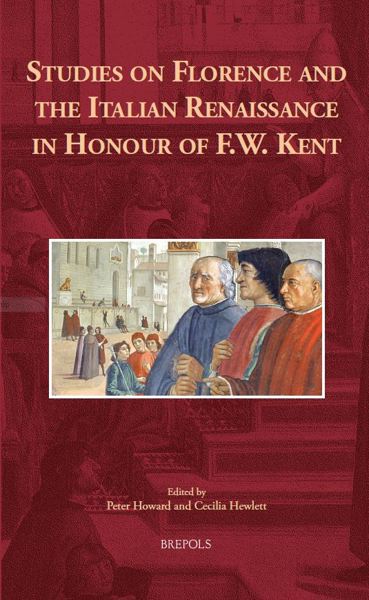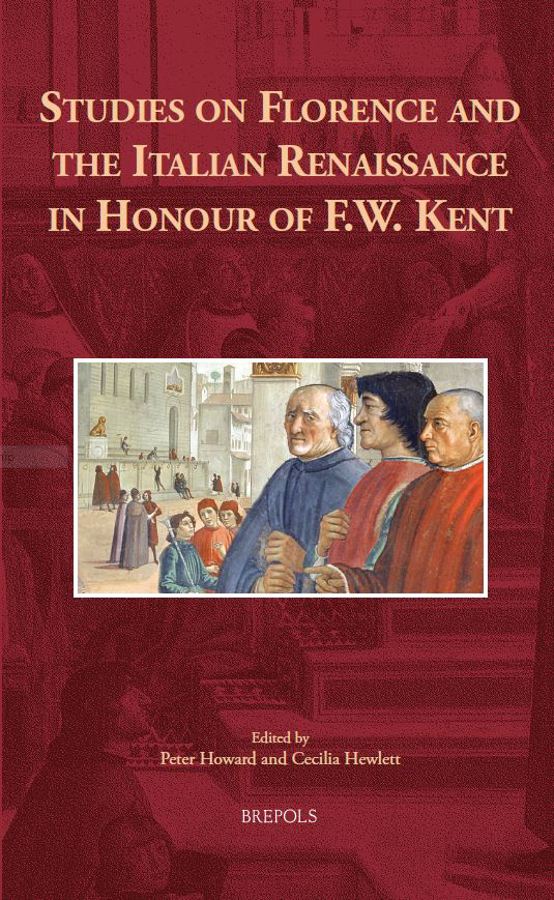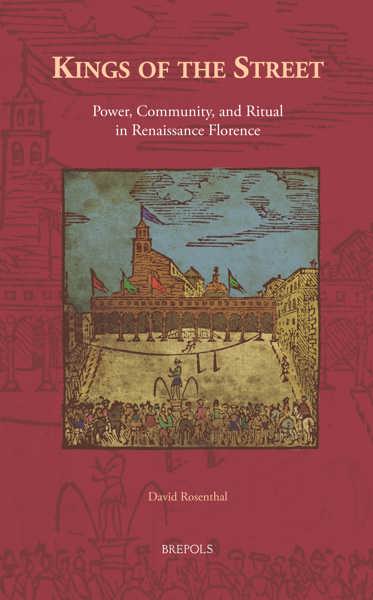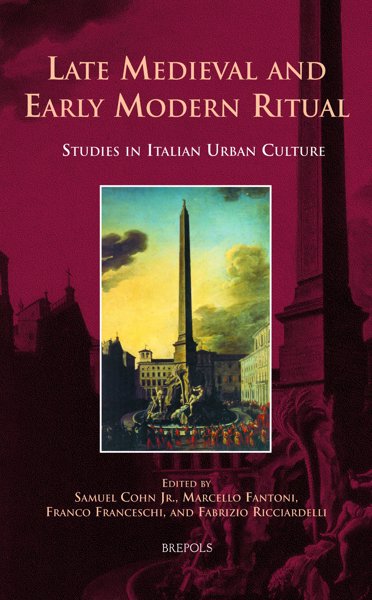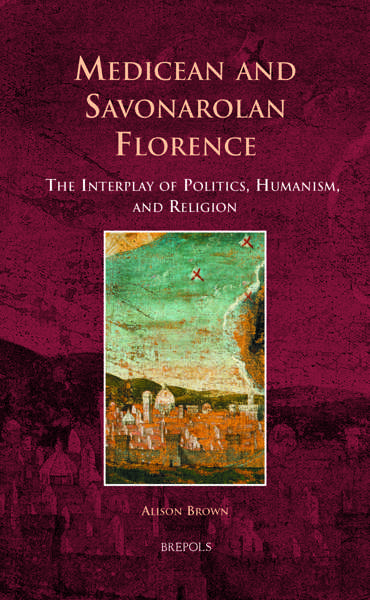
Studies on Florence and the Italian Renaissance in Honour of F.W. Kent
Peter F. Howard, Cecilia Hewlett (eds)
- Pages: 524 p.
- Size:156 x 234 mm
- Illustrations:5 b/w, 50 col.
- Language(s):English
- Publication Year:2016
- € 145,00 EXCL. VAT RETAIL PRICE
- ISBN: 978-2-503-55276-7
- Hardback
- Available
- € 145,00 EXCL. VAT RETAIL PRICE
- ISBN: 978-2-503-55822-6
- E-book
- Available
Interdisciplinary in scope and grounded in visual, literary, and archival materials, the essays in this book probe many different facets of the society of Renaissance Italy, including the role of kinship and networks, power and agency in Medicean Florence, patronage and spirituality, and the generation and consumption of culture.
“This thick volume of interdisciplinary essays edited by Peter Howard and Cecilia Hewlett is both an excellent tribute to the wide-ranging and deeply felt impact of the scholarship of Francis William (“Bill”) Kent (1942–2010) and a showcase of some of the brightest voices within current Italian Renaissance studies who formed his social network of parenti, amici, and vicini.” (Allie Terry-Fritsch, in Renaissance Quarterly, 70.4_2017, p. 1533)
“(…) all of the contributions are united in an approach that emphasizes the careful, even subtle, reading of historical traces (…) One cannot help but think that Lorenzo de’ Medici would have approved. But one is also left profoundly grateful for this final act of intellectual influence and leadership in shaping such a richly textured and rewarding volume.” (Nicholas Scott Baker, in Parergon, 34/2, 2017 p. 216)
This volume honours F.W. (Bill) Kent (1942-2010), internationally renowned scholar of Renaissance Florence and founding editor of the Europa Sacra series. Kent belonged to an energetic generation of Australians who, in the late 1960s, tackled the Florentine archives and engaged key issues confronting historians of that ever-fascinating city.
With his meticulous archival findings and contextual interpretations spanning a scholarly career of more than forty years, Kent engaged with, indeed drove, the scholarly response to many of the issues that have shaped not just our current and emerging understanding of Florence and other urban centres of Italy, but along with that, a more nuanced view of the role of frontier towns and the countryside.
Interdisciplinary in scope and grounded in visual, literary, and archival materials, the essays presented here explore a variety of facets of the society of Renaissance Italy, confronting and extending themes that have been emerging in recent decades and exemplified by Kent’s work. These themes include the role of kinship and networks, power and agency in Laurentian Florence, gender, ritual, representation, patronage, spirituality, and the generation and consumption of material culture.
Foreword
Acknowledgements
‘A paradise inhabited by Devils’: Bill Kent and his Florentine Renaissance — PETER HOWARD
Part I. Power and Agency in Medicean Florence
Between the Palace and the Piazza: Locating Power and Agency in Bill Kent’s Florence — ALISON BROWN
‘La cara e buona imagine paterna di voi’: Ideal Images of Patriarchs and Patrons as Models for the Right Ordering of Renaissance Florence — DALE KENT
Asserting Presence: Strategies of Medici Patronage in Renaissance Florence — JOHN T. PAOLETTI
The Magnificent Arbitrator: Lorenzo de’ Medici and the Patrician Families in Florence — LORENZO FABBRI
Carried Away: Lorenzo’s Triumphs of 1491 — NERIDA NEWBIGIN
‘With his authority she used to manage much business’: The Career of Signora Maria Salviati and Duke Cosimo I de’ Medici — NATALIE TOMAS
Part II. Family, Friends, Networks
Mercantile and Other Friendships in Early Renaissance Tuscany — CAROLYN JAMES
Michelangelo’s Brothers ‘at my shoulders’ — WILLIAM E. WALLACE
Transmission of Intangible Goods in Vasari: Talent, Names, Kinship — CHRISTIANE KLAPISCH-ZUBER
Protecting Dowries in Law in Renaissance Florence — THOMAS KUEHN
Commissioni and Commessi in Florence: A Preliminary Assessment of the Introduction, Diffusion and Role of Annuities in Florence, c. 1400–1580 — Lorenzo Polizzotto
‘Grande passatenpo honesto’: Filippo Strozzi’s Garden at Naples — AMANDA LILLIE
Florentine Exiles and Venetian Patricians: The Soderini Family and the Forging of New Ties — ERSIE BURKE
Part III. Spirituality and Patronage
Begging for Favours: The ‘New’ Clares of S. Chiara Novella and their Patrons — SHARON T. STROCCHIA
’Tis Better to Give than to Receive: Client–Patronage Exchange and its Architectural Implications at Florentine Convents — SAUNDRA WEDDLE
Saint Peter, the Carmelites, and the Triumph of Anghiari: The Changing Context of the Brancacci Chapel in Mid-Fifteenth Century Florence — NICHOLAS A. ECKSTEIN
Rural Pilgrims and Tuscan Miracle Cults — CECILIA HEWLETT
The Tailor’s Song: Notes from the Underground in Grand-Ducal Florence — DAVID ROSENTHAL
Authority and Punishment in the Letters of Hildegard of Bingen and Catherine of Siena — CLARE MONAGLE
Catherine of Siena, Florence, and Dominican Renewal: Preaching through Letters — CONSTANT J. MEWS
‘With open doors’ in the Tor de’ Specchi: The Chiesa Vecchia Frescoes and the Monks of Santa Maria Nova — CYNTHIA TROUP
Part IV. Consuming Culture
Leonardo Bruni and the Rise of Official Historiography in Renaissance Florence — GARY IANZITI
Interpretation and Translation: Classical Influences on Leonardo Bruni and the Art of Translation in Quattrocento Florence — ANDREA RIZZI
Ser Giovanni di Francesco, Forger of Coins and Man of ‘Ingegno’ — LORENZ BÖNINGER
Curbing ‘Ambitions of the Throat’: Alimentary Sumptuary Law in Early Modern Italy — CATHERINE KOVESI
The One about Michelangelo and the Onions: Jokes and Cultural Anxiety in the Early Sixteenth Century — JILL BURKE
The Publications of Francis William Kent
